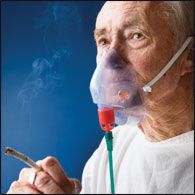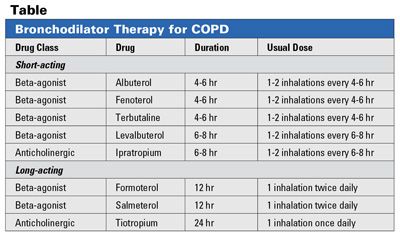Publication
Article
Pharmacy Times
Chronic Care Focus: Diagnosis and Treatment of COPD in Health Systems
Controlling chronic obstructive pulmonary disease is a priority for health systems worldwide; recently updated guidelines provide strategies for diagnosis, management, and prevention.
Dr. V. Pham is a postgraduate year-1 resident in internal medicine at the University of New Mexico Hospital, Albuquerque. Dr. D. Pham is an assistant professor of pharmacy practice at Western University of Health Sciences, College of Pharmacy, Pomona, California.

Chronic obstructive pulmonary disease (COPD) affects more than 11 million Americans and is the fourth leading cause of chronic morbidity and mortality in the United States. Although the overall disease prevalence is declining because of increased awareness of the negative effects of smoking, COPD's association with cigarette smoking remains substantial. The diagnosis and treatment recommendations for COPD have changed with the addition of newer medications.
Health systems worldwide are attempting to control COPD. In the United States, the guideline most often referred to is the Global Initiative for Chronic Obstructive Lung Disease, also known as GOLD.1 GOLD was last updated in late 2008 and provides clinicians with strategies for the diagnosis, management, and prevention of COPD.
Diagnosis
COPD is usually caused by cigarette smoking, which leads to progressive airway obstruction and inflammation. Unlike asthma, the symptoms are not fully reversible. COPD comprises both emphysema and chronic bronchitis; however, most patients have characteristics of both conditions. Emphysema is a pathologic term describing abnormal permanent enlargement of alveoli with destruction of the alveolar elastic tissue without obvious fibrosis.2 Chronic bronchitis is a clinical diagnosis defined by productive cough for most days in a period of 3 months for 2 successive years.3 Pulmonary function tests aid in diagnosis and classically show an obstructive pattern of increased total lung capacity; increased residual volume; and a decreased forced expiratory volume in 1 second/ forced vital capacity (FEV1/FVC) ratio.
Along with an extensive history of smoking, emphysema also can be caused by a rare deficiency in alpha-1- antitrypsin, which also may cause liver abnormalities. With the enlargement of alveoli and destruction of elastic fibers, lung tissue starts to compress the airway upon expiration, thus causing obstruction. Patients present with progressive shortness of breath on exertion, nonproductive mild cough, use of accessory respiration muscles, barrel-shaped chest, hyperresonant chest on percussion, scattered rhonchi, and distant heart/breath sounds.
Historically, these patients are often described as "pink puffers," because they are able to maintain adequate alveolar ventilation and normal PaCO2 by taking shallow breaths through pursed lips. Chest x-ray shows lung hyperinflation that leads to a small heart and flattened diaphragm. Diagnostic pulmonary function tests show the classic obstructive pattern, and mild hypoxemia is often seen as a result of decreased alveolar diffusing capacity.
The chronic bronchitis patient likely has a significant smoking history, which leads to increased size and number of airway mucous glands (Reid index >50). Secretion from these glands obstructs the airway, causing retention of CO2, which constricts pulmonary vessels leading to pulmonary hypertension and right-sided heart failure. In addition to a productive cough, patients present with wheezing and rhonchi upon auscultation. These patients are described as "blue bloaters," because they have decreased alveolar ventilation and increased PaCO2 and often present with edema from right-sided heart failure.
During an exacerbation, patients experience fever and an elevated white blood cell count (neutrophil predominant). Sputum cultures grow Streptococcus pneumoniae and Haemophilus influenzae. Chest x-ray shows increased lung markings in the lower fields. Although diagnosis is made clinically from a productive cough for most days for a period of 3 months for 2 successive years, pulmonary function tests provide further evidence in showing the classic obstructive pattern, as well as a normal alveolar diffusing capacity.
Both emphysema and chronic bronchitis are described as separate diseases; however, it is important to remember that the majority of patients present with both conditions simultaneously. Therefore, treatment plans should address both disease processes. Differential diagnosis includes asthma among other respiratory diseases.
Treatment Recommendations
Because COPD is an irreversible disease, none of the existing approved pharmacotherapy has been shown to change the long-term decline in lung function. Hence, medications for COPD are used to decrease symptoms and/or complications and to control the disease.
Smoking cessation is the single most overall effective and cost-effective measure to stop the progression and development of COPD.1 Studies indicate that even a brief (3-minute) consultation to urge a smoker to quit will result in smoking cessation rates of up to 10%.1 These improvements are clearly stronger than self-initiated strategies.1 Many pharmacotherapeutic agents can be used in smoking cessation. The classic "5 A's" of ask, advise, assess, assist, and arrange should be used to help the patient who is willing to quit smoking.
Bronchodilator medications are at the core of COPD management (Table). Three categories of bronchodilators may be given individually or in combination with each other. Depending on symptoms, these agents may be given around the clock, on a regular basis, or as needed.

Table
Evidence reveals that long-acting bronchodilators are more convenient and effective than short-acting bronchodilators.1 For patients who have reached the later stages of COPD, inhaled corticosteroids are indicated; combining them with a long-acting beta agonist is more effective than either agent by itself.1 Hence, approved products that contain both agents such as budesonide/formoterol (Symbicort) and salmeterol/fluticasone (Advair) are recommended in patients with severe and very severe COPD. In contrast, chronic systemic treatment with corticosteroids, such as prednisone and methylprednisolone tablets, should be avoided because of unfavorable benefit-to-risk ratio.1
Patients should receive influenza vaccine annually and pneumococcal vaccine if >65 years or <65 years with FEV1 <40% predicted.1
Choosing Medication for Formulary
The majority of medications used in COPD are similar to those used for asthma and other respiratory conditions; thus, considerations for formulary additions and deletions should involve these disease states.
Exacerbation of both asthma and COPD usually requires nebulized treatment with a short-acting beta-2 agonist such as albuterol and a short-acting anticholinergic such as ipratropium. Refractory treatment calls for either intravenous aminophylline or oral theophylline, which generally are inexpensive and sometimes necessary.
Chronic COPD is usually maintained with short-acting bronchodilators, longacting bronchodilators, and in severe COPD, inhaled corticosteroids. When patients are admitted with a medication that the health system does not have on formulary (ie, tiotropium), hospitals must continue to treat patients with medications that are available (ie, ipratropium). Keep in mind that upon discharge, patients should be assessed as to whether they should continue the medication they were given in the health system or if they should revert to the medication they were taking at home. This is important to ensure high adherence rates and efficacy of the medication.
Conclusion
Both chronic and acute COPD need to be differentiated from other similar respiratory diseases at diagnosis with the proper tools. Treatment is usually centered around bronchodilator therapy, and smoking cessation is highly recommended. Health systems need to evaluate current regimens set aside for COPD alongside regimens for treating other respiratory diseases to ensure that overlaps can be made to avoid high cost.
References
- Global Strategy for Diagnosis, Management, and Prevention of COPD. The Global Initiative for Chronic Obstructive Lung Disease (GOLD) Web site. www.goldcopd.com/Guidelineitem.asp?l1=2&l2=1&intId=2003. Accessed March 11, 2009.
- Rennard SI. COPD: overview of definitions, epidemilogy, and factors influencing its development. Chest. 1998;113(Suppl 4):S235-S241.
- Chronic bronchitis, asthma and pulmonary emphysema. A statement by the Committee on Diagnostic Standards for Nontuberculous Respiratory Diseases. Am Rev Respir Dis. 1962;85:762.







